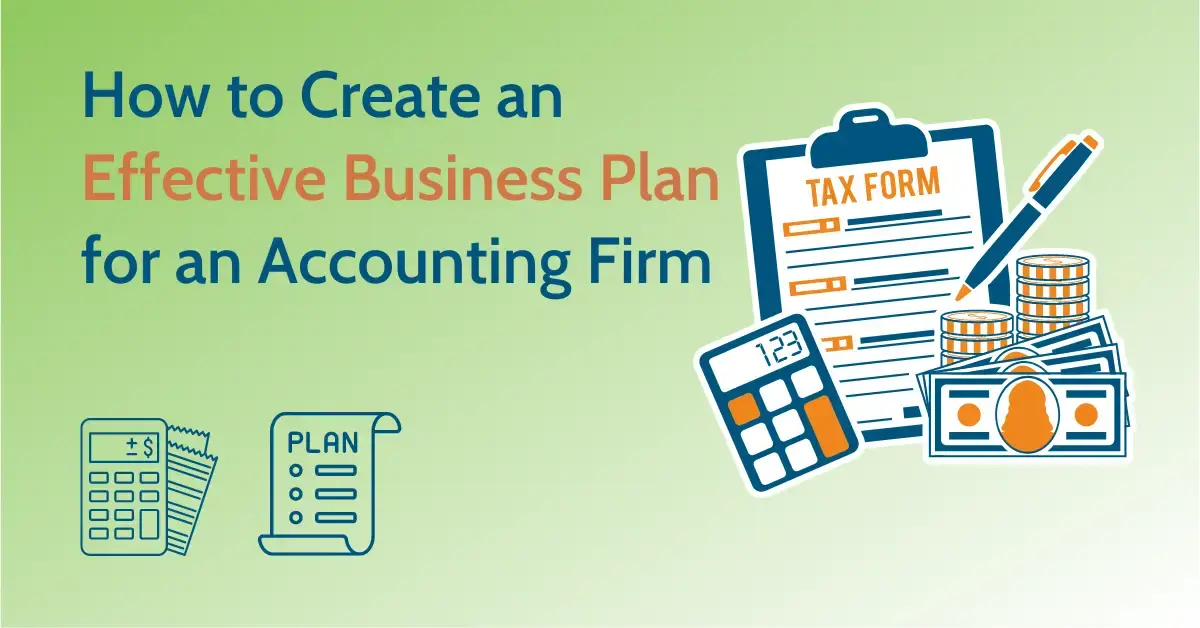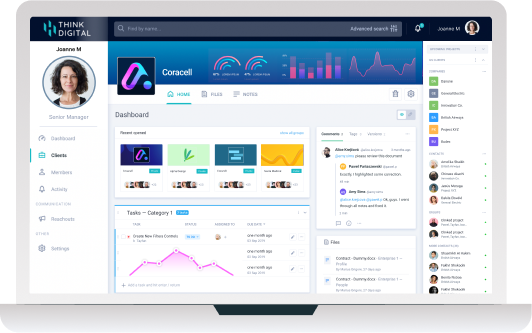Thinking of starting your own accounting firm? That's great! Getting success in the high-demand finance industry needs persistence, hard work, and proper planning.
Yes, a detailed accounting firm business plan! Whether you are preparing to raise funding, applying for loans, or want to expand the company—a business plan is the key to all.
But do you know how to write one? Worry not, you are at the right place. This guide on writing an accounting business plan effectively will help you get started.
Why do you need a business plan for your accounting firm?
If you're planning to launch a new accounting firm or thinking of expanding the existing one, a well-crafted business plan is essential. It does not only act as a roadmap for your firm's growth, but it also improves your chances of securing funding if required.
It also outlines the goals and strategies of the company, allowing you to make strong decisions that align with its long-term goals.
How to write an accounting firm business plan?
Writing an effective business plan is critical for the success of your accounting firm. It acts as a roadmap for your business. But writing it includes many steps—if you need help you can use any business planning software for support. Various steps to include in the plan are:
1. Executive summary
An executive summary is a brief overview of the entire business plan. It acts as a hook to engage readers, motivating them to further explore your business plan.
This section should include important details such as mission, goals, services briefs, marketing & sales strategies, and financial goals.
The executive summary should be concise yet comprehensive, giving readers a clear understanding of your firm's potential and value proposition.
2. Company description
Now, this is the section where you give a detailed description of your accounting firm.
Start the section by mentioning the legal structure of your accounting firm, whether it's a sole proprietorship, partnership, limited liability company (LLC), or corporation.
Also, highlight your firm's mission, values, long-term vision of the firm, location of your business, and business history (if any). You should also mention the owners of the business along with their experience and educational qualifications.
3. Market analysis
Before you start writing your business plan, conduct market research. Identify the size and scope of the market, including the number of accounting firms.
First, define your target market based on your research. Understand all their pain points and accounting needs, so you can customize your services accordingly.
After that, do the competitive analysis. Identify your direct and indirect competitors, and conduct a SWOT analysis to understand your unique selling propositions.
Mention any industry trends. You can adapt your strategies by staying informed about all the trends.
Finally, add the legal regulations you need to follow to run the accounting business in a particular location. Mention about all the licenses or permits your business needs.
4. Accounting services
This is the section, where you highlight all the services and mention how you are the best in providing them.
Give a detailed description of each service you provide. It can be about tax preparation, auditing, bookkeeping, or consulting. You can also mention the specialized services if you provide any such as business valuation, acquisition support, or anything else.
Mention if you use any special software or technology to provide such services. For example, any accounting software, client portal software, communication tools, etc.
5. Marketing and sales strategies
After mentioning your services, you need to highlight sales and marketing strategies to show how will you reach the customers.
Here, you need to identify the types of customers you are going to serve. For example, individuals, firms, small businesses, startups, or NPOs. Once you know the target audience, describe your strategies to attract them. Not only attract them but also retain the existing customers.
Some strategies your accounting firm can use are networking events, social media marketing, SEO, content marketing, email marketing, etc.
6. Operational plan
The main essence of an operational plan is to showcase how you work daily. Here explain the procedure of the services you provide.
For example, a client needs to register first, then schedule a meeting with the accountant, and then that particular accountant will be in the touch with client throughout.
With the procedure, you need to mention the timeline too, in which you will provide the services. Along with all these, mention in detail all the technologies or software you plan to purchase like project management tool, bookkeeping & accounting software, file sharing software, or some other.
7. Management team
Introduce your accounting firm's key members along with their roles, experience, and educational qualifications. This will build trust for your audience about who is behind the firm and how reliable they are.
Include brief biographies or resumes of each key team member to show their expertise. You also need to give details about the CEO or the owners of the firm.
Additionally, showcase the organizational structure of your team members and who will report to whom. Do not forget to include any advisory board or third-party consultants, if you have hired any.
8. Financial plan
Here, you have to show the financial health of your accounting firm. You need to present the financial forecasts of the firm for at least three to five years.
The financial forecasts should include profit & loss statements, cash flow statements, balance sheets, and cash flow tools.
With one view of the financial plan, your audience should get to know how much profit your business will make in the future. They should also get to know about the break-even point of the business.
9. Funding request
In the funding request section, mention the financial ask you need for your business. For that, you need to calculate the startup costs first and be clear about your requirements from investors or bankers.
Provide a breakdown of the funding required for various purposes, such as office rent, staff salaries, marketing, technology, and equipment.
Highlight the potential return on investment for investors, including projected revenue growth and profitability. If you are not writing the accounting firm's business plan for funding then you can skip this section.
10. Appendix
An appendix is kind of your supporting section, which has all the documents that support the main content of the whole business plan.
This might include resumes of the team members, detailed financial projections, customer feedback, legal documents, or any other additional information that you feel like to be added.
Including all this additional information can help provide a wider view of your accounting firm and support your business plan.
How Clinked Can Help You
Starting the adventure of managing an accounting firm can be significantly smoother with the right technological partners. Clinked is here to supercharge your firm’s operational capabilities and client interactions.

Here’s how Clinked can be a game-changer for your business:
- Secure Client Portal: Imagine a world where your clients have continuous access to a secure, branded client portal for your accounting firm. Here, they can view their financial documents, share necessary files, and communicate effortlessly with your team. This transparency not only boosts client satisfaction but also enhances client retention.
- Effortless Real-Time Collaboration: With Clinked, gone are the days of back-and-forth emails and disconnected workflows. Your team can now edit business documents simultaneously, streamline processes, and ensure that every financial statement or tax filing is perfect the first time around.
- Streamlined Task Management: Keep your projects on track with Clinked’s intuitive task management tools. Assign tasks, set deadlines, and monitor progress in a way that ensures your team is always productive and no client query goes unanswered.

- Uncompromised Security and Compliance: In the realm of accounting, securing sensitive information is paramount. Clinked fortifies your client data with state-of-the-art security measures and ensures compliance with the latest financial regulations, thereby nurturing trust and maintaining your firm’s esteemed reputation.
- Mobile Accessibility: In today’s fast-paced world, access to information on the go is not just a luxury—it’s a necessity. With Clinked’s mobile app, your team and clients can remain connected and operational from anywhere, at any time, facilitating unparalleled flexibility and responsiveness.
By integrating Clinked into your daily operations, you not only streamline complex processes but also enhance your firm’s overall productivity and client service capabilities. With Clinked, you’re not just surviving in the competitive accounting industry; you’re thriving.
Conclusion
So that's it! That is how you write an effective accounting firm business plan. If you are still confused about how to write one, then in this AI phase, you can use an AI business plan generator to write your plan or free business plan template.
Using an AI business plan generator can save you time and effort, allowing you to focus on other aspects of your business. Therefore, using these tools can be beneficial for business owners, entrepreneurs, and individuals.
Alongside AI tools, integrating platforms like Clinked can further enhance your business operations and client interactions. Clinked offers a secure, customizable client portal, real-time collaboration tools, and mobile access to manage your business effectively from anywhere. These features ensure that your accounting firm not only meets but exceeds client expectations, setting you apart in a competitive industry. Embrace these technological solutions, and propel your firm towards a successful future.
Read More:
- How To Start An Accounting Firm
- 8 Best Project Management Software for Accounting Firms
- Virtual Accounting Firm: How To Make It A Success
- 8 Best Accounting Practice Management Software in 2024









Let Us Know What You Thought about this Post.
Put your Comment Below.